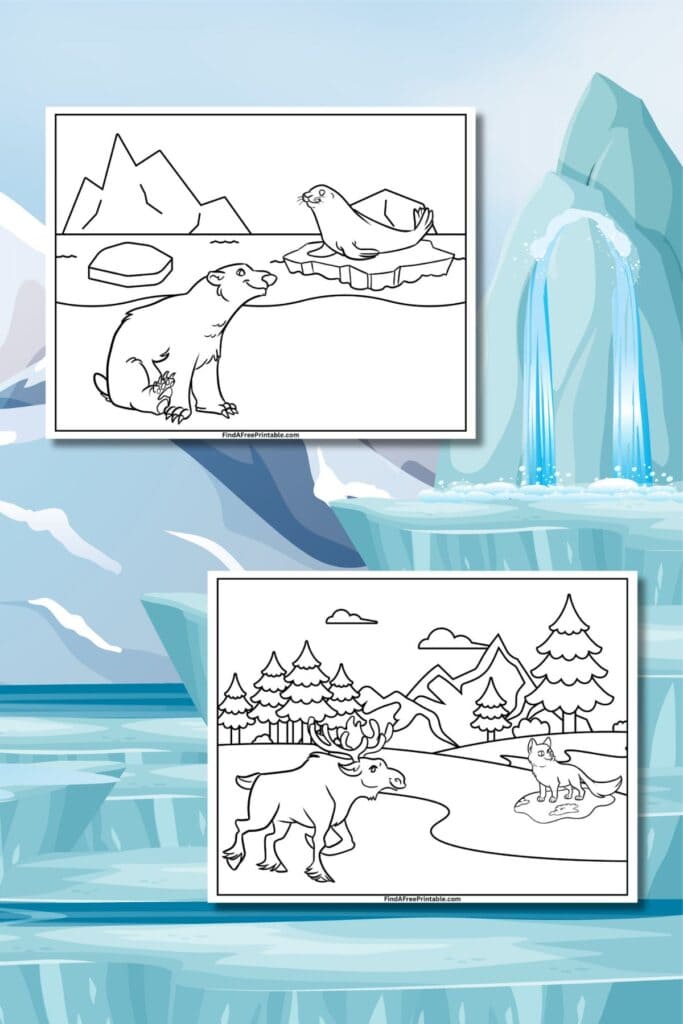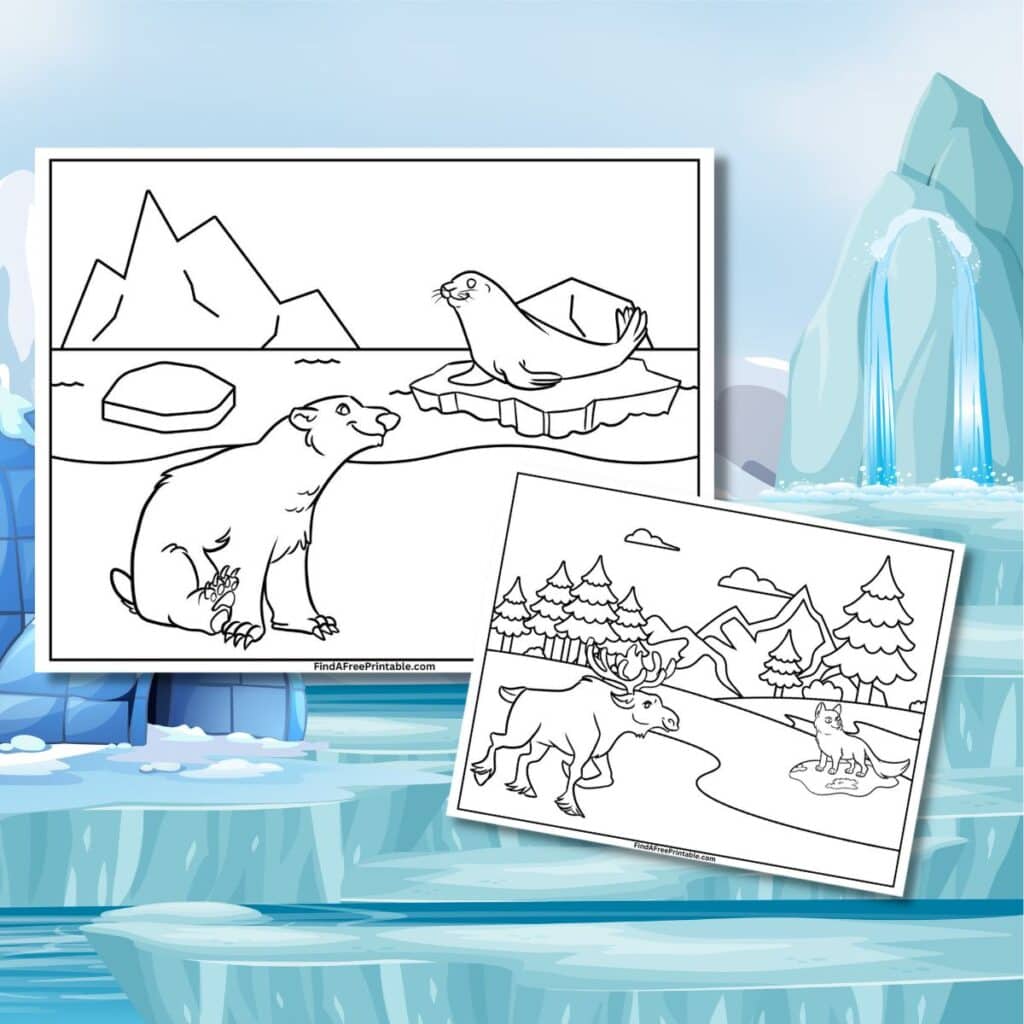Arctic Animal Coloring Pages are a fun way to enjoy some winter activities at home! These unique coloring sheets are a perfect gift for kids of all ages. This will be good to improve fine motor skills as well. Get your little artist working right away – just download and print as much as you need!

WHAT ANIMALS ARE CONSIDERED ARCTIC ANIMALS?
Many creatures are regarded as Arctic animals because they have come to adjust to the severe environment and weather of the region. Among the most popular arctic animals are the following:
POLAR BEARS
One of the world’s biggest land carnivores, these magnificent animals are indigenous to the Arctic zone. The largest terrestrial predators on Earth, these top predators hunt seals, their primary prey.
ARCTIC FOX
To help keep them warm in the winter, these little foxes have legs that are short and packed fur. They consume whatever they come across, such as carrion, birds, and lemmings. They are both opportunistic feeders and scavengers.
WALRUSES
These massive marine creatures scrape clams and other shellfish from the seafloor with their huge tusks. Additionally, they are gregarious species that come together in big groups on glaciers and coastlines.
HARP SEAL
The Arctic is home to a variety of seal species. Among which are harp, bearded, and ringed seals. They depend on the sea ice for reproduction and pupping, and they are all expert swimmers and divers.
REINDEER / CARIBOU
These massive herbivores travel great distances to reach their eating sites in the summer and the winter. Their coats of fur and specially designed hooves allow them to move around on ice and snow.
MUSK OXEN
To avoid predatory animals, these big, shaggy-haired bovids reside in groups. Their broad, snowshoe-shaped hooves let them tread on snow and ice. While their thick fur and underfur protect them against freezing temperatures.
ARCTIC HARE
These massive hares can hear better and travel more swiftly in the snow due to their gigantic ears and legs. In the cold season, they blend in with their surroundings because of their white coat.
SNOW OWL
A snowy owl is a big white owl that has impressive hunting skills. They are able to stealthily soar across the air to capture their food. Which consists of mice, rabbits, and lemmings. They also possess outstanding ability to hear and see.
BELUGA WHALE
The high-pitched noises that these white whales produce have earned them the nickname “sea canaries” as well. They are friendly critters that inhabit groups of up to several hundred animals. They consume crabs, squid, and fish.
NARWHALS
These unusual whales are distinguished by the length of their tusks, which are essentially extended teeth. They gobble up fish, squid, and crustaceans and reside in tiny pods.

WHERE DO ARCTIC ANIMALS LIVE?
There are two primary domains that make up the Arctic region: the land and the sea. In this enormous and varied ecosystem, different Arctic wildlife will live in different places according to their distinctive requirements and adaptations. Here are the different areas depending where they are:
LAND
1. Tundra – Almost the whole Arctic mainland is covered in this treeless area of constantly frozen ground, known as permafrost. In this section, creatures including musk oxen, lemmings, reindeer or caribou, snowy owls, and Arctic foxes can be found here. They use the cliffs and limited flora as shelter and food sources.
2. Arctic Mountains – These rocky, rough mountains serve as home to mountain hares, ptarmigans, and several predatory birds, including gyrfalcons and golden eagles.
3. Freshwater Environments – A variety of creatures, including beavers, Arctic char, and waterfowl like ducks and geese, use lakes, rivers, and wetlands as vital freshwater sources and nesting sites.
SEA
1. Sea Ice – Many aquatic animals, including walruses, ringed seals, and polar bears, depend on this drifting structure for resting, hunting, and reproducing.
2. Open Water – A broad spectrum of fish, invertebrates like krill and plankton, and underwater creatures including bowhead, narwhal, and beluga whales can be found flourishing in the open ocean as well as under the ice.
FUN FACTS ABOUT ARCTIC ANIMALS
While the older kids are working on this great activity of free arctic animals pages, they can enjoy learning about these winter arctic animals. There are lots of interesting things to know about these creatures. Check out this list of cool things about them:
ANTI FREEZE BLOOD
Certain fish, such as the Arctic cod, have unique blood proteins that function as anti-freeze, keeping them from solidifying in the chilly water.
INTERNAL FURNACE
Musk oxen and reindeer have distinct muscle capabilities that produce warmth, leaving them toasty in the coldest weather.
UNDERWATER CAMOUFLAGE
Because of their dark-colored undersides, seals are less noticeable to attackers from down below. Yet their white fur seamlessly blend in into the snow from above the water.
LIFE CYCLE
Over the course of a few years, lemming populations bloom and bust; some beliefs even imply that they leap into the water to commit a wave of suicides. This is improbable, though, given their immense numbers only serve to draw in predators and cause population collapses.

POLAR BEAR HUNTING TECHNIQUE
These crafty predators will follow seals at breathing holes and wait quietly for them to come out. They may even “pat” the ice with their paws to draw intrigued seals.
ARCTIC FOX DENS
Sometimes, in order to provide shelter and raise their offspring, these cunning foxes hijack other creatures’ caves. For instance those of owls or rabbits.
POLAR DAY AND NIGHT
Many species’ behaviors and activity patterns are impacted by the Arctic’s full blackness in the winter and constant sunshine in the summer.
ARCTIC FOXES AND SNOWY OWLS
While these creatures may clash over food, occasionally they come to a brief truce. In which the owl gains from the fox’s capacity to scavenge leftovers and the fox benefits from the owl’s excellent vision in locating prey.
THE NORTHERN LIGHTS
Because there is less illumination in the Arctic, this captivating light show (caused by charged rays from the sun clashing with Earth’s atmosphere) is evident there.
FREE PRINTABLE ARCTIC ANIMALS COLORING PAGES FOR KIDS
The best part about these arctic animal coloring pages is that it’s totally free for you to download. Just click on the download link below for your own personal use. Easy as that, you will be ready to print the instant download pdf file and use them immediately!
If you enjoyed this printable coloring pages post, be sure to check out these other new coloring pages next time:
- Free Printable Basketball Hoop Coloring Pages for Kids
- Mardi Gras Color by Number
- Free Printable Succulent Coloring Pages to Download
Be sure to PIN this for LATER and SHARE on FACEBOOK!
